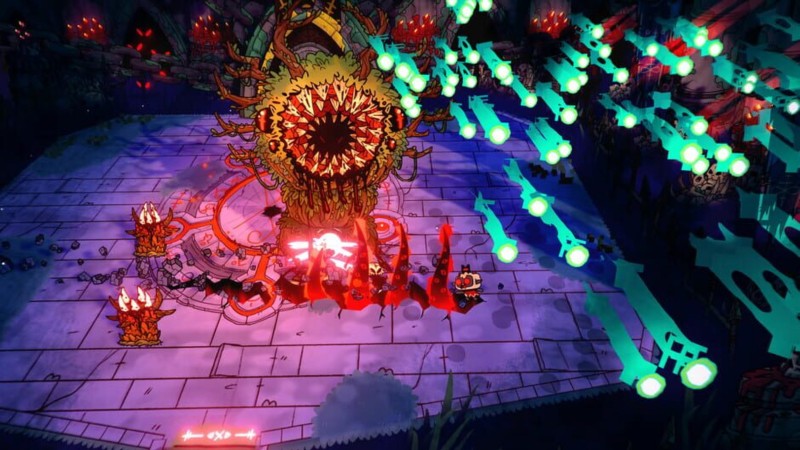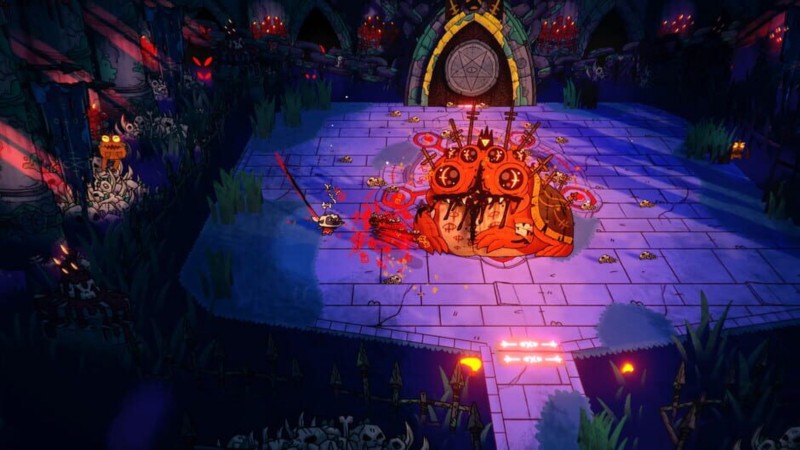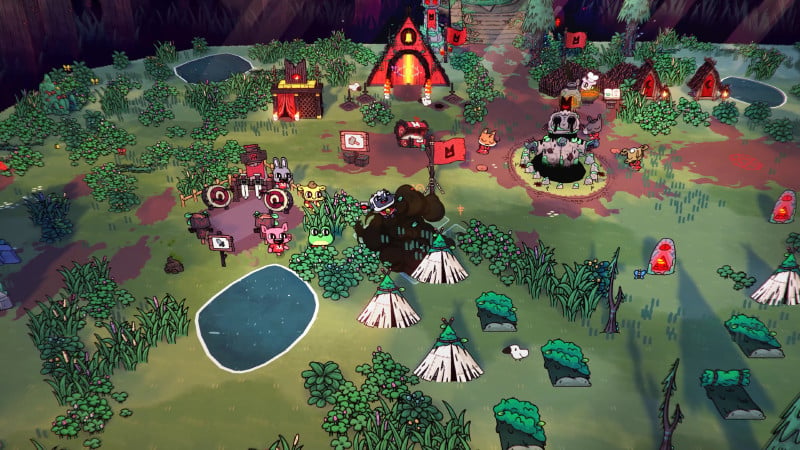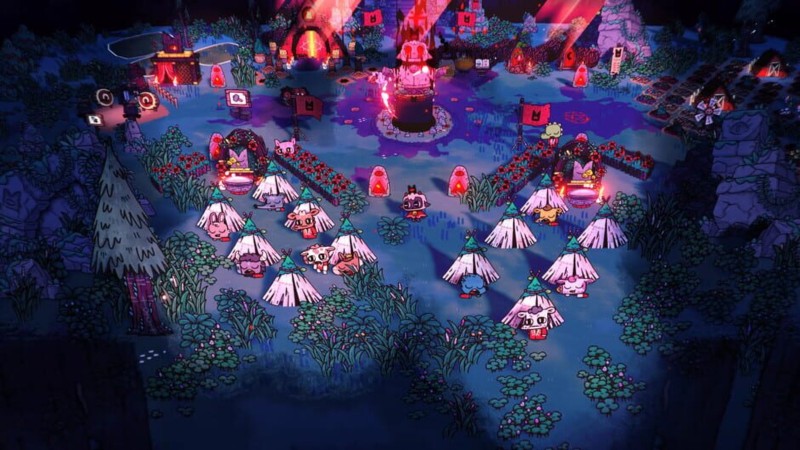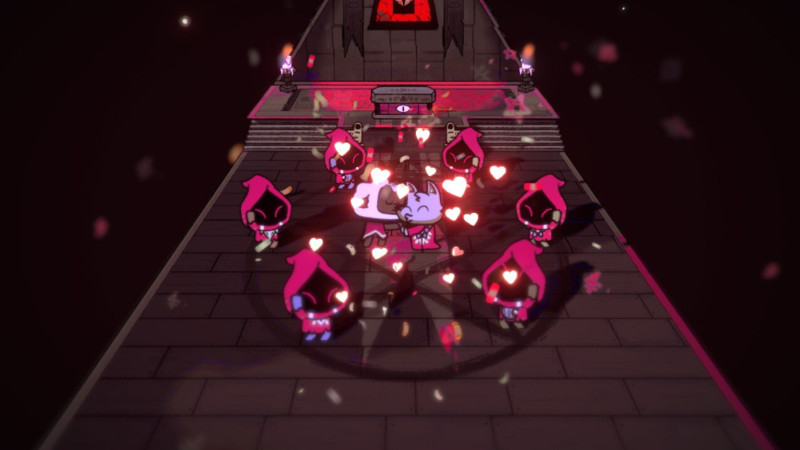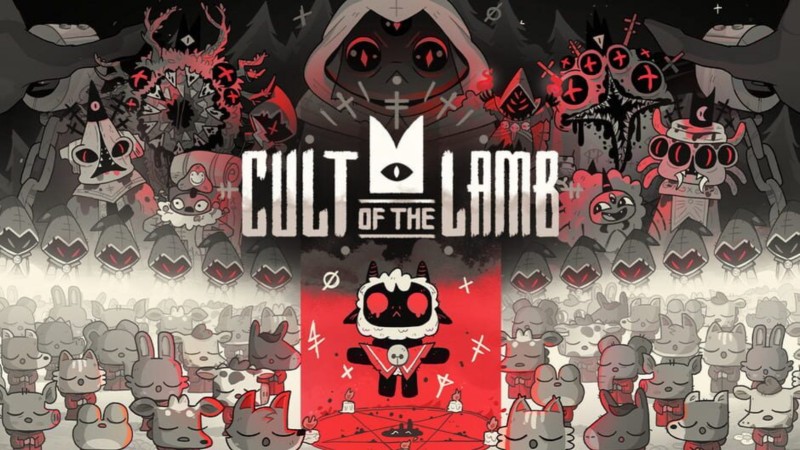
Reviewed on:
PC
Platform:
PlayStation 5, Xbox Series X/S, PlayStation 4, Switch, PC
Publisher:
Devolver Digital
Developer:
Massive Monster
Release:
August 11, 2022
Rating:
Teen
I loved Animal Crossing: New Horizons back in 2020, but its premise wasn’t enough to keep me engaged over time. Designing my island and keeping all of the villagers on it happy was thoroughly enjoyable, but after a few dozen hours, I craved a new type of gameplay to coincide with what I was doing each day. Cult of the Lamb, a mish-mash of adorably cute animals, critters, and creatures and macabre cult-isms, remedies that issue with an expansive action-combat dungeon system. I only wish its base building provided the same kind of satisfaction its combat does. When I wanted to focus on designing a cult aesthetically, I found the game pushing my hand towards focusing on resource management, chipping away at the fun I was having otherwise. Building your cult from the ground up and designing its headquarters is fun, but you’re soon pushed into using your cult as a means of manufacturing in-game currencies and resources, and this sometimes gets in the way of actually making my cult feel like home.
Cult of the Lamb’s premise is simple – you’re a lamb sacrificed to four gods. However, upon death, you discover a fifth god, one the others locked away. They grant you a second lease on life; all you need to do to obtain it is start a cult in their name. And that’s where my journey in Cult of the Lamb began. Nearly 20 hours later, I rolled credits with a cult of more than 20 followers of The Pearl programmed to keep me, their leader, happy, powerful, and stocked with everything I needed. The story that fueled my time in Cult of the Lamb was enough to keep me going, but it takes a back seat to everything else in the game. There’s lore to glean from run-ins with the gods you encounter mid-dungeon, and NPCs will reveal some backstory too, but gameplay comes first here. And for good reason.
Combat is slick and crunchy, with each attack carrying weight as you battle through randomly arranged dungeons. One room might be jam-packed with skeletons, spiders, killer caterpillars, and cloaked assassins. Using my lamb’s dodge roll, I can escape incoming projectiles and dagger slashes and then counter with my blade, which also has the chance to heal me upon killing an enemy. I close out the dungeon using combo-heavy claws against a boss, relying on the weapon’s randomly-assigned necrotic ability to fling dead enemies back at the boss as projectiles.
Weapons, like the rooms I found them in, appear at random, keeping combat fresh. Curses, magic-like attacks that typically amount to a projectile or close-combat area-of-effect damage, are random too, but I relied on them a lot less to succeed in the game’s four main dungeons. Curses have limited use because they require Fervor dropped by enemies to use. However, by the end of the game, between pick-up tarot cards that grant special bonuses and other lamb-specific traits, I seldom worried about running out of curses. But I also rarely even used curses, finding them to be more disruptive than not to my flow state; I instead relied on standard attacks and my dodge roll for success in battle.
I also had to hone in on the progression of my base, which is where my followers worship and work for me, all to make my lamb stronger so that my next dungeon run, or crusade as it’s dubbed in-game, would be easier. My base began small, with just a shrine for collecting worship devotion and a temple for performing cult-strengthening sermons and beneficial-but-risky rituals. Over time, I learned that my base required much more to succeed. Everything builds on each other, and each system works because of another system happening in-game, so I began to view my cult as a machine whose purpose was to worship, empower, and strengthen me more than as a place to express my inner cult designer. The importance of resource management, as well as the stress of managing cult members’ happiness by keeping them fed, completing their quests, and ensuring their loyalty, often stole the time out of each in-game day. This left little time to make my cult aesthetically pleasing, something I would have liked.
And that was fine – it’s clearly what developer Massive Monster intended of these mechanics – but with so many cosmetic items thrown into the formula, I was disappointed by how rarely I was afforded the time to focus on them. I wanted to make my cult look and feel like mine, but the pull of resource management often got in the way.
I began the game by naming each follower, designing them to look like one of my dogs, cat, or even my friends. But, after about a dozen hours, I was less engrossed with the simulation aspect of it all, opting to stick with default follower designs, and more focused on completing the next dungeon and upgrading the next building in my cult. That said, running through dungeons and improving my cult compound was satisfying, and I found plenty of enjoyment in Cult of the Lamb as a result, even when I felt more like a ruthless boss than a leader.
In the post-game cleanup, I’m only now engaging with the aesthetic-serving aspects of Cult of the Lamb. I’m finally making my cult feel like mine and not one I’m sure every other player will at some point make to cultivate as many resources as possible. I only wished I had felt this earlier in my 19-hour journey. Still, everything I did leading up to it, from the fast-paced dungeon combat that never grew stale to the factory-like base building that nailed the stress of resource management, was enough and then some to keep me engaged and indoctrinated.
Score:
8
About Game Informer’s review system
Source: Game Informer Cult of the Lamb Review – Follow The Leader


